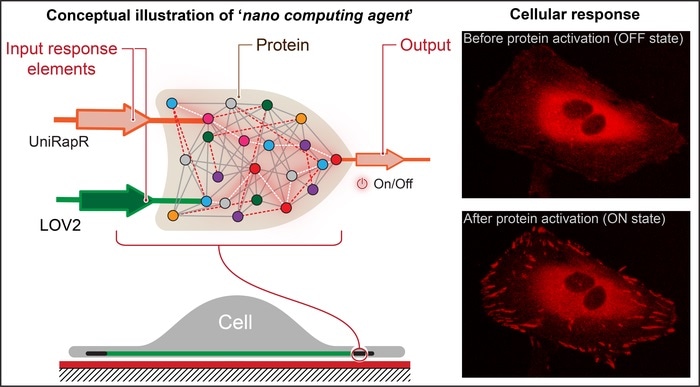Developing nanoscale computers to use in precision health care was the dream of numerous researchers and medical practitioners. Scientists from Penn State for the first time developed a nano computing agent that regulates the function of a specific protein involved in cell movement and cancer metastasis. The study leads the way for building complex nanoscale computers for preventing and treating cancer and other diseases.

Researchers created a transistor-like “logic gate,” which is a type of computational operation in which multiple inputs control an output, and embedded it into a protein. They found that not only could they rapidly activate the protein using light and the drug rapamycin, but also that this activation resulted in the cells undergoing internal changes that enhanced their adhesive capabilities, which ultimately decreased their motility. Image Credit: The Pennsylvania State University.
Nikolay Dokholyan, G. Thomas Passananti Professor, Penn State College of Medicine, and his co-workers—including Yashavantha Vishweshwaraiah, a postdoctoral scholar in pharmacology, Penn State—developed a transistor-like “logic gate,” a kind of computational operation where multiple inputs regulate an output.
Our logic gate is just the beginning of what you could call cellular computing, but it is a major milestone because it demonstrates the ability to embed conditional operations in a protein and control its function. It will allow us to gain a deeper understanding of human biology and disease and introduces possibilities for the development of precision therapeutics.”
Nikolay Dokholyan, G. Thomas Passananti Professor, Penn State College of Medicine
The group’s logic gate had two sensor domains devised to retort to two inputs—light and the drug rapamycin. The researchers focused on the protein focal adhesion kinase (FAK) as it is involved in cell adhesion and movement, the first steps in metastatic cancer development.
First, we introduced a rapamycin-sensitive domain, called uniRapr, which the lab had previously designed and studied, into the gene that encodes FAK. Next, we introduced the domain, LOV2, which is sensitive to light. Once we optimized both domains, we combined them into one final logic-gate design.”
Yashavantha Vishweshwaraiah, Postdoctoral Scholar, Pharmacology, Penn State College of Medicine
The researchers introduced the modified gene into HeLa cancer cells and with the help of confocal microscopy noted the cells in vitro. They analyzed the impact of each input separately and also the combined effects of the inputs, on the behavior of the cells.
The researchers found that they can swiftly activate FAK with the help of light and rapamycin. This activation resulted in the cells undergoing internal changes that improved their adhesive abilities, which in turn reduced their motility.
The study was published on November 16th, 2021, in the Nature Communications journal.
We show for the first time that we can build a functioning nano computing agent within living cells that can control cell behavior. We also discovered some interesting features of the FAK protein, such as the changes it triggers in cells when it is activated.”
Yashavantha Vishweshwaraiah, Postdoctoral Scholar, Pharmacology, Penn State College of Medicine
Dokholyan remarked that the researchers anticipate testing these nano computing agents in vivo within living organisms.
Source:
Journal reference:
Vishweshwaraiah, Y. L., et al. (2021) Two-input protein logic gate for computation in living cells. Nature Communications. doi.org/10.1038/s41467-021-26937-x.